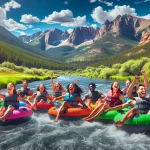Set against the San Juan National Forest, Mesa Verde National Park in southwestern Colorado is home to some of the most remarkable archaeological sites in North America. These sites include the ancient cliff dwellings of the Ancestral Puebloans, also known as the Anasazi. Built into the sides of cliffs, these awe-inspiring structures offer a fascinating glimpse into the lives and culture of the Native Americans who inhabited the region over 700 years ago. The park’s well-preserved, enchanting ruins and rich cultural heritage make it a must-visit destination for history buffs and outdoor enthusiasts alike.
In This Article
TL;DR
- Mesa Verde National Park features the spectacular cliff dwellings of the Ancestral Puebloans, also known as the Anasazi.
- The park's archaeological sites provide insights into the lives and culture of the ancient Native Americans.
- Visitors can tour the cliff dwellings, learn about Ancestral Puebloan history, and enjoy the park's natural beauty.
Destination Overview
Mesa Verde National Park is a UNESCO World Heritage Site renowned for its incredible Ancestral Puebloan cliff dwellings. The park offers each Mesa Verde visitor the unique opportunity to intimately explore these ancient structures and learn about the fascinating history of the Anasazi people who built them. In addition to the archaeological wonders, Mesa Verde boasts the stunning natural beauty of Southwest Colorado, with its rugged canyons, mesas, and diverse wildlife.
Local Experiences and Culture
Visiting Mesa Verde allows you to immerse yourself in the rich cultural heritage of the Ancestral Puebloans. As a national park service, guided tours of the cliff dwellings, such as the famous Cliff Palace and Balcony House, provide insight into the daily lives and architectural prowess of the ancient inhabitants.
For visitors looking for more than a guided tour, the national park also hosts cultural demonstrations and events showcasing traditional crafts, music, and storytelling. These events allow each Mesa Verde visitor to connect with the living descendants of the Anasazi. The Chapin Mesa Archaeological Museum in the park is an enriching point of interest for learning about the ancestral Pueblo people and more.
Archaeological Heritage and Excavation
Mesa Verde is a testament to the archaeological significance of the Ancestral Puebloans. The park’s well-preserved ruins have been the subject of extensive archaeological excavations, which have revealed valuable information about the Anasazi’s social structure, religious practices, and technological advancements. Ongoing research and excavations continue to shed light on this ancient civilization, with new discoveries being made regularly.
Ancestral Puebloans and Their Legacy
The Ancestral Puebloans, or Anasazi, were a complex society that thrived in the Four Corners region of Southwest Colorado from around 600 to 1300 CE. The ancestral Pueblo people were skilled farmers, potters, weavers, and architects, as evidenced by the intricate cliff dwellings and artifacts found at Mesa Verde and its archaeological sites. The Anasazi’s legacy lives on through their descendants, the modern Pueblo people, who continue to honor their ancestors’ traditions and cultural practices.
Cliff Dwellings and Ancient Architecture
The cliff dwellings at Mesa Verde are architectural marvels, showcasing the ingenuity and adaptability of the Ancestral Puebloans. These multi-story structures were built into the sides of cliffs, using a combination of stone, mortar, and wooden beams. The dwellings featured intricate room layouts, kivas (ceremonial chambers), and even sophisticated water management systems. Remarkably, some of these structures, like the Sun Temple dwelling, incorporate mathematical concepts like the golden ratio in their design.
One of the things that makes the mysterious Sun Temple unique is that it was designed solely for ceremonial purposes and not for actual dwelling. The Sun Temple and Cliff Palace View are not to be missed, and it’s recommended that visitors bring binoculars.
Environmental Challenges and Preservation
Mesa Verde faces various environmental challenges, including the threat of megadroughts, wildfires, and erosion. The park’s dedicated national park service works tirelessly to preserve the delicate ruins and protect the site’s cultural and natural resources. The Native American Graves Protection and Repatriation Act (NAGPRA) is crucial in ensuring the respectful treatment of ancestral remains and sacred objects found within the park.
Spiritual and Ceremonial Significance
The Anasazi had a rich spiritual life, as evidenced by the numerous kivas and ceremonial structures found throughout Mesa Verde. Kivas, which are circular underground chambers, served as important gathering places for religious ceremonies, social events, and political meetings. Oral histories passed down through generations, combined with archaeological evidence, provide valuable insight into the spiritual beliefs and practices of the Anasazi.
Agriculture and Lifestyle
The Anasazi were skilled farmers who adapted to the challenging environment of the Mesa Verde region. They practiced mesa-top farming, growing crops like corn, beans, and squash on the flat tops of the mesas. The Anasazi also lived in pithouses, semi-subterranean dwellings that provided shelter and storage for food and supplies. Despite the success of the ancestral Pueblo people, various factors, including climate change and social upheaval, likely contributed to their eventual migration from the area in the late 13th century.
FAQ
What is the best time of year to visit Mesa Verde National Park?
The park is open year-round, but the best time to visit is from spring through fall when the weather is mild and the cliff dwellings are accessible.
Are there guided tours available at Mesa Verde?
Yes, the park offers a variety of guided tours, including park ranger-led tours of the cliff dwellings and backcountry hikes in places like the San Juan National Forest.
Can visitors enter the cliff dwellings on their own?
No, to protect each delicate dwelling, visitors can only enter the cliff dwellings as part of a guided Verde tour led by park rangers.
Are there accommodations available within the park?
Yes, the park has a campground and the Far View Lodge, which offers comfortable rooms and stunning views of the surrounding landscape.
What should visitors bring when exploring Mesa Verde?
Visitors should bring comfortable walking shoes, sun protection, water, and snacks. Binoculars can also be helpful for spotting wildlife and appreciating the panoramic views.
Is Wetherill Mesa Road closed?
The Wetherill Mesa area of Mesa Verde National Park was closed for 2023 and will possibly stay closed for 2024 for two major construction projects.
What is the Step House, and when is it open?
The Step House is a cliff-dwelling that visitors can tour on their own without a guided tour. It’s open only between spring and fall, so it’s recommended to check the hours of operation.
Can I do a guided tour of the Balcony House?
Yes, in the summer, visitors can do a guided tour of the Balcony House, which is a mid-sized village of 38 rooms.
Does Mesa Verde National Park have a visitor center?
Yes, Mesa Verde National Park has a main visitor center for educational and research purposes. There is also the historic Far View Visitor Center, but it is currently vacant.






